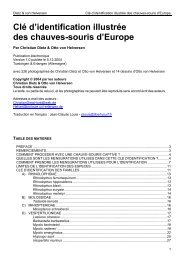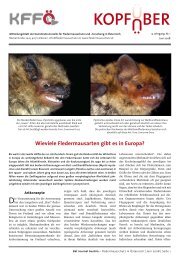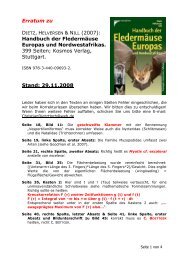Dietz & von Helversen Illustrated Identification key to the bats of ...
Dietz & von Helversen Illustrated Identification key to the bats of ...
Dietz & von Helversen Illustrated Identification key to the bats of ...
You also want an ePaper? Increase the reach of your titles
YUMPU automatically turns print PDFs into web optimized ePapers that Google loves.
<strong>Dietz</strong> & <strong>von</strong> <strong>Helversen</strong><strong>Illustrated</strong> <strong>Identification</strong> <strong>key</strong> <strong>to</strong> <strong>the</strong> <strong>bats</strong> <strong>of</strong> Europe<strong>the</strong> tibia. Cell <strong>of</strong> <strong>the</strong> wing membrane between <strong>the</strong> first joint <strong>of</strong> <strong>the</strong> fifth finger and <strong>the</strong>elbow not divided by a keel (Fig. 174 - 177) (only some very big females <strong>of</strong> P.pipistrellus show sometimes a weak keel). – 33) slightly bigger species, FA: 29.2 – 33.5 mm (in extremes 28.0 – 34.5 mm), D5: 37– 41 mm, D3: 50 – 56 mm. Without internarial ridge between <strong>the</strong> nostrils (Fig. 165,184) (only very dehydrated individuals do sometimes show a weakly developedridge). The muzzle is longer and gradually narrowing. The glandular bumps are white(Fig. 186) or sometimes whitish-grey. The length <strong>of</strong> <strong>the</strong> inner margin <strong>of</strong> <strong>the</strong> ear islonger (8 - 9 mm) (Fig. 166). The pelage is dense but not as smooth as in P.pygmaeus and dark brown on <strong>the</strong> back, <strong>of</strong>ten rusty, sometimes a paler mediumbrown. Ears and muzzle are mostly black (Fig. 164 and 166), but in <strong>the</strong> south <strong>of</strong> <strong>the</strong>range some adults have a pale area around <strong>the</strong> eyes. Face and ears differ stronglyfrom <strong>the</strong> pelage by <strong>the</strong>ir dark coloration. The penis is dark grey <strong>to</strong> greyish-brown and<strong>the</strong> glans penis with a contrasting pale median stripe (Fig. 167, 189). The wing cellconnecting <strong>the</strong> first joint <strong>of</strong> <strong>the</strong> fifth finger with <strong>the</strong> elbow is not divided by anadditional keel (Fig. 174, 175 and 192), but <strong>the</strong> cell above this is quite short, it usuallydoes not extend <strong>to</strong> <strong>the</strong> forearm (Fig. 174 and 175). – Pipistrellus pipistrellusAdditional characters: In most individuals <strong>the</strong> second phalanx <strong>of</strong> <strong>the</strong> 3rd finger (P3.2) is 1 -3 mm longer than <strong>the</strong> 3rd phalanx (P3.3) (Fig. 194), but sometimes <strong>the</strong>y are <strong>of</strong> similarlength (P3.2: 7.9 – 8.9 mm, P3.3: 6.0 – 8.4 mm). There is usually no gap between <strong>the</strong>second and third lower incisors, <strong>the</strong>y are in contact (I 2 and I 3 ). Terminal frequency around45 kHz (43 – 49 kHz, in extremes 41 – 52 kHz).Distribution in Europe: The species is distributed all over Europe <strong>to</strong> sou<strong>the</strong>rn Scandinaviaand <strong>the</strong> Baltic states. Its nor<strong>the</strong>rn limit <strong>of</strong> distribution is fur<strong>the</strong>r south than in P. pygmaeus.In some Mediterranean areas P. pipistrellus is rarer than P. pygmaeus, but in most centralEuropean countries P. pipistrellus is <strong>the</strong> most common and widespread bat.Taxonomical note: Within this species or species group some taxonomic questions stillrequire clarification: some populations in eastern Thrace, <strong>the</strong> Peloponnese and on some51







